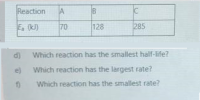
Chemistry
10th Edition
ISBN: 9781305957404
Author: Steven S. Zumdahl, Susan A. Zumdahl, Donald J. DeCoste
Publisher: Cengage Learning
expand_more
expand_more
format_list_bulleted
Concept explainers
Question
12.2

Transcribed Image Text:Reaction
E. (kJ)
70
128
285
d)
Which reaction has the smallest half-life?
e)
Which reaction has the largest rate?
Which reaction has the smallest rate?
Expert Solution
arrow_forward
Step 1
Chemical kinetics is the branch of chemistry that mainly deals with the rate of reaction and change in the concentration of reactant and product molecules with time. The rate of reaction expresses by the rate law which states that the rate of reaction is directly proportional to the active concentration of reactant molecules.
arrow_forward
Step 2
Activation energy is the minimum energy that is needed to convert reactant to product molecules. Thus for a chemical reaction to be occurred, the correct orientation of molecule and activation energy is needed.
The half-life of a reaction indicates the time in which the half of the reactant changes to product of its original amount.
Step by stepSolved in 4 steps

Knowledge Booster
Learn more about
Need a deep-dive on the concept behind this application? Look no further. Learn more about this topic, chemistry and related others by exploring similar questions and additional content below.Similar questions
- 10.109 A 0.204 M NaOH solution is used to titrate 50.0 mL of an H,PO, solution. (10.7) a. Write the balanced chemical equation. b. What is the molarity of the H;PO4 solution if 16.4 mL of the NaOH solution is required?arrow_forwardK Please don't provide the handwriting solutionarrow_forward1.6arrow_forward
- 12 A community has experienced the following exponential growth in population and water consumption. If vered the rate of expected population growth remains equal to the observed growth rate in the 2000s, but the of 2.00 per capita water consumption rate stabilizes (stays steady) at 158 gpd (gallon/day). stion Year Population Water Consumption (MGD: Million Gallon/Day) 2000 45,000 6.30 2010 61,000 9.45 Calculate the projected water demand MGD(million gallon per day) in 2020.arrow_forwardtry > Course Homearrow_forwardNonearrow_forward
- Chemistry using the information from tablearrow_forwardThe boiling point of water is (1) 212°F (2) 0°C (3) 373 K O all of 1, 2, and 3 none of 1, 2, and 3 O 1 and 2 only O 1 and 3 only. O 2 and 3 onlyarrow_forwardMolecules interacting. It's a rare event to see a water molecule hanging out by itself. Because of the unique kind of bonds found in a water molecule, a water molecule is meaning that regions of the molecule are somewhat more positive, while other regions are somewhat more negative. This property allows one water molecule to form hydrogen bonds with three other water molecules. 5.1. Draw a picture below showing four water molecules interacting via hydrogen bonds. Be sure to label partial charges in each molecule and use a dotted line to represent a hydrogen bond.arrow_forward
arrow_back_ios
arrow_forward_ios
Recommended textbooks for you
 ChemistryChemistryISBN:9781305957404Author:Steven S. Zumdahl, Susan A. Zumdahl, Donald J. DeCostePublisher:Cengage Learning
ChemistryChemistryISBN:9781305957404Author:Steven S. Zumdahl, Susan A. Zumdahl, Donald J. DeCostePublisher:Cengage Learning ChemistryChemistryISBN:9781259911156Author:Raymond Chang Dr., Jason Overby ProfessorPublisher:McGraw-Hill Education
ChemistryChemistryISBN:9781259911156Author:Raymond Chang Dr., Jason Overby ProfessorPublisher:McGraw-Hill Education Principles of Instrumental AnalysisChemistryISBN:9781305577213Author:Douglas A. Skoog, F. James Holler, Stanley R. CrouchPublisher:Cengage Learning
Principles of Instrumental AnalysisChemistryISBN:9781305577213Author:Douglas A. Skoog, F. James Holler, Stanley R. CrouchPublisher:Cengage Learning Organic ChemistryChemistryISBN:9780078021558Author:Janice Gorzynski Smith Dr.Publisher:McGraw-Hill Education
Organic ChemistryChemistryISBN:9780078021558Author:Janice Gorzynski Smith Dr.Publisher:McGraw-Hill Education Chemistry: Principles and ReactionsChemistryISBN:9781305079373Author:William L. Masterton, Cecile N. HurleyPublisher:Cengage Learning
Chemistry: Principles and ReactionsChemistryISBN:9781305079373Author:William L. Masterton, Cecile N. HurleyPublisher:Cengage Learning Elementary Principles of Chemical Processes, Bind...ChemistryISBN:9781118431221Author:Richard M. Felder, Ronald W. Rousseau, Lisa G. BullardPublisher:WILEY
Elementary Principles of Chemical Processes, Bind...ChemistryISBN:9781118431221Author:Richard M. Felder, Ronald W. Rousseau, Lisa G. BullardPublisher:WILEY

Chemistry
Chemistry
ISBN:9781305957404
Author:Steven S. Zumdahl, Susan A. Zumdahl, Donald J. DeCoste
Publisher:Cengage Learning

Chemistry
Chemistry
ISBN:9781259911156
Author:Raymond Chang Dr., Jason Overby Professor
Publisher:McGraw-Hill Education

Principles of Instrumental Analysis
Chemistry
ISBN:9781305577213
Author:Douglas A. Skoog, F. James Holler, Stanley R. Crouch
Publisher:Cengage Learning

Organic Chemistry
Chemistry
ISBN:9780078021558
Author:Janice Gorzynski Smith Dr.
Publisher:McGraw-Hill Education

Chemistry: Principles and Reactions
Chemistry
ISBN:9781305079373
Author:William L. Masterton, Cecile N. Hurley
Publisher:Cengage Learning

Elementary Principles of Chemical Processes, Bind...
Chemistry
ISBN:9781118431221
Author:Richard M. Felder, Ronald W. Rousseau, Lisa G. Bullard
Publisher:WILEY